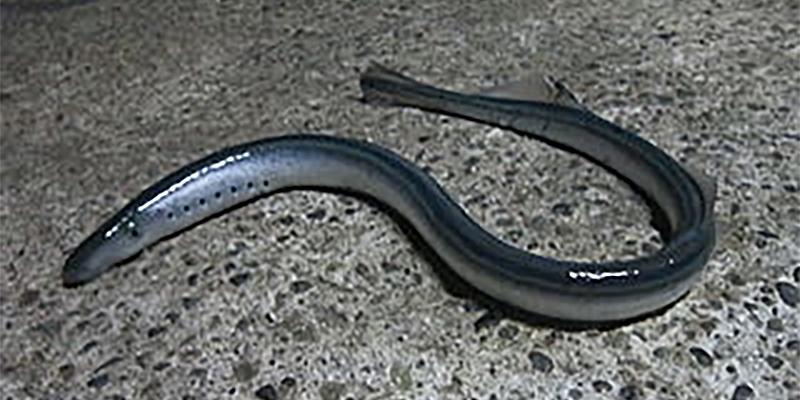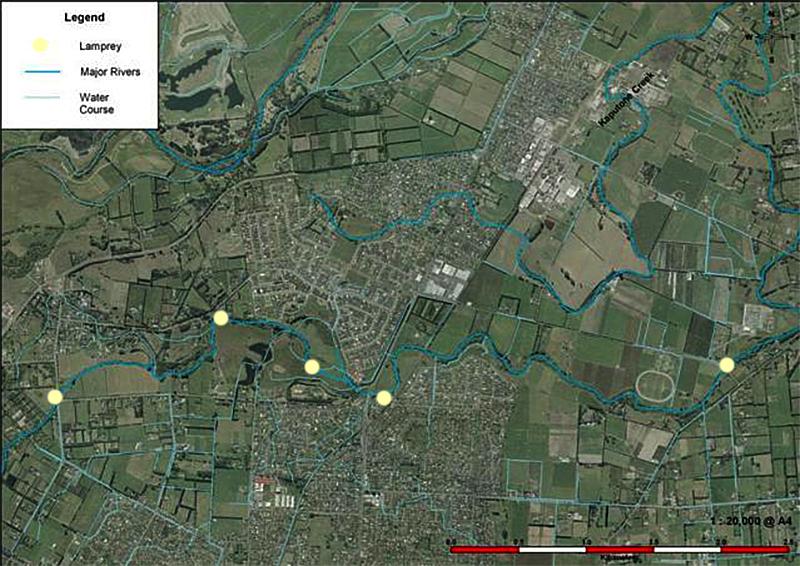Southern Lamprey
Common name Southern Lamprey
Scientific name
Geotria australis
International Distribution
Chatham Islands, Campbell and Auckland Islands, Australia (in part), Tasmania, Argentina, Chile, Falkland Island, Tierra del Fuego, South Georgia (McDowall 1990).
National Distribution
Indigenous (native) fish. Widespread in slow flowing lowland waterways throughout New Zealand.
Distribution in the Styx River
Lamprey have been occasionally identified in the mainstem of the Styx River and the Marshland Road Drain
Fishery
The adult lamprey (or kanakana) used to form an important Maori fishery in some South Island Rivers. It is known that lamprey were caught from the nearby Kaiapoi River (Anderson 1988), and they may have been fished from the Styx River as well. There are still traditional fisheries (Mahinga kai) sites in the Mataura River and elsewhere in New Zealand (Jellyman et al. 2002). Elaborate weirs and traps were made to capture migrants, and descriptions and photos of these techniques can be found in McDowall (1990).
Biology
The southern lamprey is a primitive fish-like animal with a bizarre life cycle The juveniles, called ammocoetes, live in river silts, where they filter feed for on average about 3.5 years (Kelso et al. 1993; Todd & Kelso 1993). The juveniles metamorphose and go to sea, where they parasitise marine fish and mammals. After some years at sea, the adults return into freshwater to spawn (Jellyman et al. 2002). In 1999, a migrating adult lamprey was identified in that stretch of the Styx River located within Styx Mill Conservation Reserve (Eldon & Taylor 1990). The presence of ammocoetes indicates that at least some lamprey spawning still takes place in the catchment.
In recent years, lamprey spawning has been researched, including the radio-tagging of individual lamprey in Okuti Stream in the Lake Forsyth catchment (Jellyman et al. 2002). The results of these and other studies indicate that lamprey are likely spawn within stream gravels or boulders in the upper reaches of rivers (Kelso & Glova 1993).
References
- Crossland, A. 2003. Ecological values and wildlife opportunities of the lower Heathcote Valley floodplain. Report for the Parks and Waterways Unit, Christchurch City Council.
- Anderson, A. J. 1988. Transcript of evidence presented at the Ngai Tahu mahinga kai hearing of the Waitangi Tribunal, Tuahiwi Marae, April 1988. No. p.
- Eldon, G. A.; Taylor, M. J. 1990. Fisheries survey of the Styx River, summer 1990. MAF Fisheries, Christchurch. New Zealand Freshwater Fisheries Report No. 120. 27 p.
- Jellyman, D. J.; Glova, G. J.; Sykes, J. R. E. 2002: Movements and habitats of adult lamprey (Geotria australis) in two New Zealand waterways. New Zealand Journal of Marine and Freshwater Research 36: 53-65.
- Kelso, J., R. M.; Glova, G. J. 1993: Distribution, upstream migration and habitat selection of maturing lampreys, Geotria australis, in Pigeon Bay Stream, New Zealand. Australian Journal of Marine and Freshwater Research44: 749-759.
- Kelso, J. R. M.; Todd, P. R.; 1993: Instream size segregation and density of Geotria australis ammocoetes in two New Zealand streams Ecology of Freshwater Fish 2: 108-115.
- McDowall, R. M. 1990: New Zealand Freshwater Fishes: A Natural History and Guide. Auckland, Heinemann Reed. 553 p.
- Todd, P. R.; Kelso, J. R. M. 1993: Distribution, growth and transformation timing of larval Geotria australis in New Zealand. Ecology of Freshwater Fish 2 (3): 99-107.



